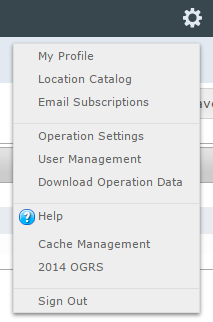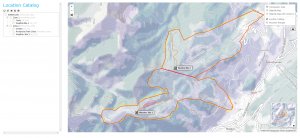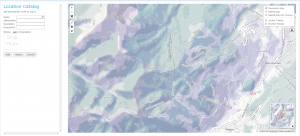| REQUIREMENTS |
| Permission |
Operation Administrator or higher |
| Connectivity |
Online only |
This document describes how to add locations to the location catalog of your operation.
Step-by-step description
| 1.
|
 Fig. 1: Administration menu for operation administrator |
| 2.
|
 Fig. 2: Location catalog screen The location catalog screen shows your location hierarchy tree on the right and a Google Earth map on the right.
|
| 3.
|
Expand the location hierarchy tree on the right as required by clicking on the little plus (+) signs left of locations that contain other locations.
| ISSUE |
The order of locations within the location tree is currently somewhat random, which make it difficult to navigate through large location trees. It is intended that the locations within each location parent would eventually be sorted by location type and name to make navigation easier.
Workaround: See Searching for a location in the location catalog.
JIRA: -832 (Sept. 22, 2013) |
|
| 4.
|
 Fig. 3: Location catalog with highlighted location and administrative buttons  above the top left corner of the location catalog (Fig. 3) or right click on the parent location itself and select 'New'. In both cases, a list of location types supported under the current parent location appears. Choose the appropriate type for your new location. above the top left corner of the location catalog (Fig. 3) or right click on the parent location itself and select 'New'. In both cases, a list of location types supported under the current parent location appears. Choose the appropriate type for your new location.
|
| 5.
|
 Fig. 4: Location catalog page when adding a new avalanche path location. You will now be presented with a blank Google Earth map and a dialog box for information about the new location on the left (Fig. 4). Enter the following information for the new location into the fields provided:
- Name (required): Full name of the location
- Abbreviation (required): Abbreviation to be used for the location in the tabular InfoEx reports.
- Description: Detailed description of the location
- External ID: The external ID of a location is required if your operation submits their observations from an external database system via the API (see How to submit observation to the InfoEx via the CAAML 3.0.3 API for more information). The external ID is also required for locations that already existed in the legacy CAAML driven InfoEx and have historic observation associated with them.
- Elevation (weather site only): Elevation of weather site in meters.
| NOTE |
Since locations are primarily referred to by name in the InfoEx system, it is not advisable to create multiple location of the same type with the same name. However, the system currently does not explicitly check for it. |
|
| 6.
|
Add an appropriate geometry to the location. See Location types and symbology for details on the supported geometries for the different location types.
There are currently two options for adding geometries to a location:
| ISSUE |
Drawing directly in the Google Earth map has not been implemented yet
JIRA: -132 (Sept. 22, 2013)) |
|
| 7.
|
Click on Add to add the new location to the location tree of the operation. This will close the pop-up window and add the new location to the location tree.
| ISSUE |
Even though the information for the new location is committed to the system, the pop-up window does not always close.
Workaround: After clicking on Add, click on Cancel to close the window.
JIRA: -795 (Aug. 24, 2013) |
| ISSUE |
The main Google Earth map currently does not instantly update after any edits to the location catalog.
Workaround: To see the newly added location, exit the location catalog page of the application (e.g., go to reports) and come back to the location catalog page to refresh it.
JIRA: -831 (Sep. 22, 2013) |
|
Related documents
Functionality tested by
- Oct. 21: Pascal Haegeli / QA Server / Test Version 0.31.00



